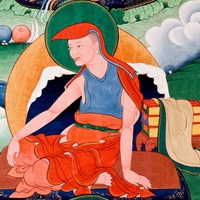
Buddhapalita
Buddhapalita (Sangs-rgyas bskyangs, Skt. Buddhapālita), counted among the Seventeen Nalanda Masters, was born around 470 CE in Hamsakrida, in southern India. Although details regarding his life are few and far between, it is known that he took an interest in religious life at a young age, becoming ordained and excelling in his formal studies early on. At Nalanda, under the guidance of Sangharakshita (dGe-’dun srung-ba, Skt. Saṅgharakṣita), a disciple of Nagamitra (Klu’i bshes-gnyen, Skt. Nāgamitra), who in turn was a disciple of Nagarjuna (Klu-grub, Skt. Nāgārjuna), he became very learned in Buddhist scriptures – especially those of Nagarjuna – and engaged in intense meditative practices. His meditation was so successful that it is said that he attained siddhis, or extraphysical powers, and had visions of Manjushri.
Later on, he resided at Dantapuri Monastery in present-day Andhra in south India and taught there the texts of Nagarjuna, Aryadeva (’Phags-pa’i lha, Skt. Āryadeva), Shura (dPa’-bo, Skt. Śūra), and others. It is during this time that he wrote the Buddhapalita Commentary on (Nagarjuna’s) “Root (Verses on) Madhyamaka” (dBu-ma rtsa-ba’i ’grel-pa buddha-pā-li-ta, Skt. Buddhapālita Mūlamadhyama-vṛtti), an influential commentary on Nagarjuna’s foundational text on Madhyamaka philosophy. Buddhapalita’s work provided great insight and clarity into Nagarjuna’s view of voidness, so much so that later he came to be regarded as the founder of the Prasangika Madhyamaka school. His work, however, was also criticized by some of his contemporaries, such as Bhavaviveka (Legs-ldan ’byed, Skt. Bhāvaviveka), credited as the founder of the Svatantrika Madhyamaka school.
Buddhapalita is thought to have passed away in around 540 CE.